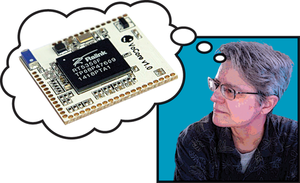It's a Big World
Welcome to this issue of Raspberry Pi Geek!

Welcome to this issue of Raspberry Pi Geek!
Welcome to this issue of Raspberry Pi Geek, where we connect small-board computers (SBCs) to the world outside with sensors, Android GUIs, servers, and even a Scratch chat program.
The ever-useful I2C port figures in a couple of articles that keep you abreast of what is going on around you. A lightning detector is not only interesting to deploy, but it could help keep your electronics safe. In another article, the Raspberry Pi teams up with a temperature sensor chip to monitor temperature and turn a fan on and off. Outside the I2C port, XBee modules create a distributed wireless sensor network that reports back to a Raspberry Pi.
If you want to interact with your Rasp Pi through your Android cellphone or tablet, we have two articles that can help. In one article, the WebSocket protocol, which lets you set up communications over TCP, is used to create a Raspberry Pi server and an Android client. If you want to bypass the coding, on the other hand, you can drag-and-drop to create a mobile interface that communicates with your SBC using the Blynk platform.
[...]
Pages: 1
Price $15.99
(incl. VAT)